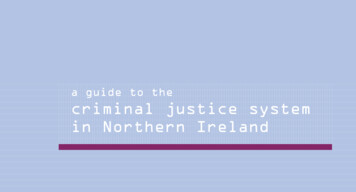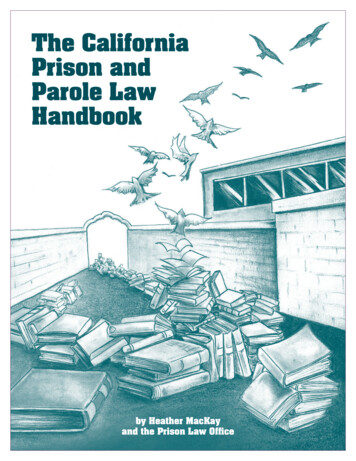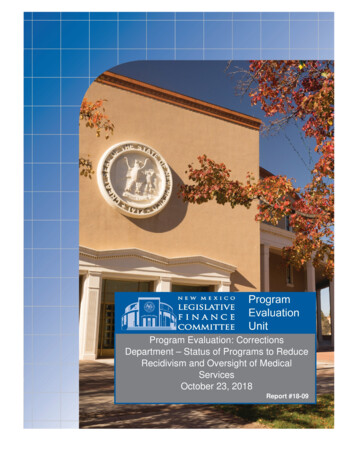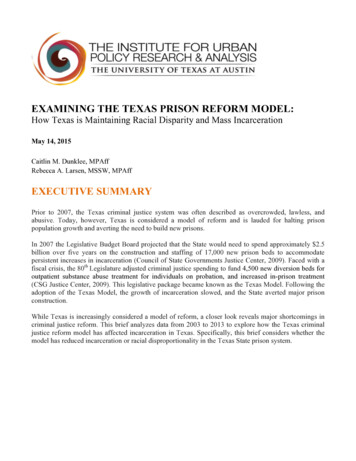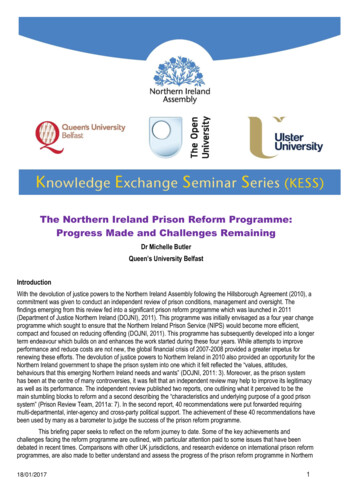
Transcription
The Northern Ireland Prison Reform Programme:Progress Made and Challenges RemainingDr Michelle ButlerQueen’s University BelfastIntroductionWith the devolution of justice powers to the Northern Ireland Assembly following the Hillsborough Agreement (2010), acommitment was given to conduct an independent review of prison conditions, management and oversight. Thefindings emerging from this review fed into a significant prison reform programme which was launched in 2011(Department of Justice Northern Ireland (DOJNI), 2011). This programme was initially envisaged as a four year changeprogramme which sought to ensure that the Northern Ireland Prison Service (NIPS) would become more efficient,compact and focused on reducing offending (DOJNI, 2011). This programme has subsequently developed into a longerterm endeavour which builds on and enhances the work started during these four years. While attempts to improveperformance and reduce costs are not new, the global financial crisis of 2007-2008 provided a greater impetus forrenewing these efforts. The devolution of justice powers to Northern Ireland in 2010 also provided an opportunity for theNorthern Ireland government to shape the prison system into one which it felt reflected the “values, attitudes,behaviours that this emerging Northern Ireland needs and wants” (DOJNI, 2011: 3). Moreover, as the prison systemhas been at the centre of many controversies, it was felt that an independent review may help to improve its legitimacyas well as its performance. The independent review published two reports, one outlining what it perceived to be themain stumbling blocks to reform and a second describing the “characteristics and underlying purpose of a good prisonsystem” (Prison Review Team, 2011a: 7). In the second report, 40 recommendations were put forwarded requiringmulti-departmental, inter-agency and cross-party political support. The achievement of these 40 recommendations havebeen used by many as a barometer to judge the success of the prison reform programme.This briefing paper seeks to reflect on the reform journey to date. Some of the key achievements andchallenges facing the reform programme are outlined, with particular attention paid to some issues that have beendebated in recent times. Comparisons with other UK jurisdictions, and research evidence on international prison reformprogrammes, are also made to better understand and assess the progress of the prison reform programme in Northern18/01/20171
Knowledge Exchange Seminar Series 2016-17Ireland. Lastly, some recommendations are put forward regarding the proposed adoption of an outcomes basedapproach to accountability in this area.Current AchievementsOne of the key ambitions of the prison reform programme in Northern Ireland was to support and strengthenrehabilitation, resettlement and desistance work. This involved NIPS balancing the need to ensure security and goodorder with a regime which supported and facilitated change. While NIPS has experienced challenges in this regard,overall they have taken a number of substantial steps in enhancing resettlement, rehabilitation and desistanceprovision. These steps have lead the Criminal Justice Inspectorate Northern Ireland (CJINI) to judge performance inthis area to have improved from their pre-reform levels across all four prisons in Northern Ireland. NIPS have alsosought to encourage more engagement between staff, those imprisoned and their families. In some cases NIPS, inconjunction with outside agencies, have facilitated families in playing a more active role in encouraging and supportingchange by keeping families informed about the progress of those imprisoned and offering them an opportunity to beinvolved in challenging inappropriate behaviour.The cooperation and engagement between NIPS and outside agencies has also been built on and increased.This has led to a number of innovative approaches being piloted by NIPS and outside agencies in the area of wellbeing,employment, rehabilitation and desistance. Some examples of this work include the transformation of Hydebank Woodinto a Secure College, various social enterprise initiatives as well as work programmes with business partners, localcommunities, the arts and the voluntary/community sector. While this work demonstrates promise, it has not yet beendeveloped to its full potential due to the wider fiscal challenges affecting Northern Ireland, which have in turn limited theability of NIPS and outside agencies to invest in and expand these initiatives. Nonetheless, this work has led to anumber of awards, certificates and recognition of excellence for both staff, those imprisoned and those involved indesigning and overseeing these projects. The majority of these initiatives have focused on improving familyrelationships, employability and/or the education of those imprisoned, in line with the priorities identified in the DOJIN(2013) ‘Reducing Offending’ and DOJNI (2015a) ‘Supporting Change’ strategies. There has also been an increasedfocus on mentoring and enhancing the wellbeing of those imprisoned through a range of formal and informalmechanisms.In addition, efforts have been ongoing to improve the experience of living and working in Northern Irelandprisons by reconfiguring and developing the prison estate. While some of this work has already begun, other partsremain subject to funding. The reconfiguration and development of the prison estate should help to improve theconditions for both staff and those imprisoned there, by providing better environments designed to increasesurveillance, safety and wellbeing, as well as lessen the impact of managing the detention of those seeking to be heldin separated conditions. While the recent reduction in the daily average prison population, witnessed during 2015/2016,has helped to ease some of the pressures on the prison estate as well as the provision of services within NorthernIreland prisons, it remains unclear if this reduction is a short-term occurrence or the beginning of a longer term trend.As NIPS are expected to detain those imprisoned by the Courts, NIPS has little control over who or how many people itimprisons. Legislative, policing, prosecution and sentencing decisions play an important role in this regard and,consequently, influence the capacity of NIPS to provide secure, humane conditions for those living and working there.Endeavours within the prison reform programme, and wider criminal justice system following the transfer of justicepowers to the Northern Ireland Assembly, have sought to reduce the use of custodial sentences by encouraging theadoption of effective non-custodial options in cases deemed to be suitable and appropriate for such options. Since thereform programme began, these efforts have led to a reduction in the number of young males, females and finedefaulters imprisoned, helping to ease some of the pressures on NIPS, the prison estate and service provision.Another goal of the prison reform programme was to lessen the costs associated with imprisonment. WhileNIPS was already attempting to decrease costs prior to the introduction of the reform programme, since its introduction,the cost per prisoner place in 2015/2016 has been reduced by approximately 27 per cent from the cost per prison placein 2009/2010. While this is a substantial reduction, its achievement has brought a number of challenges which continueto effect the reform programme and work in this field.2
Knowledge Exchange Seminar Series 2016-17Ongoing ChallengesIn its first report, the independent prison review cautioned that “should the change simply aim to save money: acheaper service could be a worse service” (Prison Review Team, 2011b: 44). Unfortunately, the level of savings thatNIPS have been required to achieve has affected their ability to invest in new strategies and fund rehabilitative anddesistance work (DOJNI, 2015b). NIPS has cautioned that this reduction in their resources has negatively impacted ontheir ability to fund voluntary and community sector initiatives, as recommended in the reform programme (DOJNI,2015b). In addition, they have warned that further cuts and/or an increase in the prison population may lead toinsufficient staff resources, probation and psychological services, as well as a greater number of people spending moretime locked in their cells due to a reduced regime (DOJNI, 2015b). Given the requirement to make an additional 4.1 percent real terms reduction in public service budgets in the coming year, combined with the economic uncertaintysurrounding the decision to leave the EU (ITV, 2016), the potential impact of these events on NIPS, service provision,the voluntary and community sector as well as the prison reform programme is worrying.Another issue facing NIPS and the reform programme is the management of those with severe and enduringmental health problems, personality disorders and those held in separated conditions. Concerns about the facilitiesavailable to deal with those with mental health and/or personality disorders are not new, with some concerns expressedas far back as the passing of the Government of Ireland Act 1920 (Ministry of Home Affairs, 1923). Despite efforts toimprove the wellbeing of those imprisoned, worries remain about the ability of prisons to cope with those with mentalhealth problems and/or personality disorders (CJNI, 2016; 2015; 2009; Committee for Health, 2016). Questions havebeen raised about whether such individuals should be held in prison given their needs and the difficulties involved inmeeting these needs in a prison environment (CJNI, 2016; 2015; 2009; Committee for Health, 2016). These concernsremain despite the reform programme and the transfer of prison healthcare to the Department of Health (Butler, 2016a;Committee for Health, 2016; Committee for Justice, 2016a). Attempts to resolve these concerns require legislativeaction, greater inter-departmental cooperation and communication, improved capacity to deal with mental illness(including personality disorder and co-occurring disorders) amongst high risk individuals in healthcare and justicesettings as well as an ability and willingness by the Courts to divert such individuals to alternative institutions.The management of those seeking to be held in separated conditions also poses ongoing challenges. Whilemany may wish to see an end to the separated regime, there are a number of factors that make this difficult. Theseinclude: the shape and size of the prison estate; the current fiscal climate; history of imprisoning those linked to IrishRepublicanism and Loyalism in separated conditions; as well as the ability of their regime conditions to contribute to themobilisation of support for such groups, protests, disorder and violence in prison and in communities (Butler, 2016b).The wider political, social and economic conditions giving rise to the demand expressed by those entering prison to beheld in separated conditions means that resolving this issue will require action by more than just NIPS and the DOJNI.Indeed, all government departments, political parties and the wider public will need to work together to try to reduce theinfluence of paramilitary groups within communities and encourage greater political, social and economic integrationthroughout Northern Ireland. This should help lessen the demand expressed by those entering prison to be held inseparated conditions and, therefore, over time negate the need for a separated regime with Northern Ireland prisons(Butler, 2016b).The first report of the independent review also highlighted a need to improve relationships between prison staffand management, ensure adequate succession planning during times of personnel change, enhance perceptions ofleadership and develop a more comprehensive strategy for the provision of healthcare in prison (Prison Review Team,2011b). While steps have been taken to develop a comprehensive prison healthcare strategy, improve relationshipsbetween prison staff, management and the Prison Officers Association, as well as the leadership provided withinprisons, there remains scope for building on and strengthening these endeavours. NIPS recognise that more work isrequired and have listed the development of staff and leadership across all levels of the organisation as a strategicpriority for 2016/2017 (NIPS, 2016). Similarly, the South Eastern Health and Social Care Trust (SEHSCT), who haveresponsibility for overseeing and delivering healthcare in prison, recognise that more work is required in this area andthat existing service provision needs to be reviewed (Committee for Health, 2016). Some of the factors affecting work in3
Knowledge Exchange Seminar Series 2016-17this area include an increase in staff turnover, higher than desired sickness levels, ongoing security risks as well asstaff retention and recruitment difficulties (Committee for Justice, 2015, 2016a; Committee for Health, 2016). Theseissues need to be addressed and stabilised as staffing levels, and the approach of staff towards their work, plays animportant role in shaping service provision, levels of safety, security, culture, regime conditions and reform efforts.Moreover, the greater responsibility given to outside agencies to deliver key prison services requires great careto be taken to ensure that the agreements governing these relationships are appropriate, meet the needs of thepopulation and take account of the challenges posed by working in a prison environment. It is also necessary to ensurethat these agreements acknowledge how changes implemented by one organisation can affect others and have asubstantial impact on the wider culture, regime, working conditions and reform efforts. For this reason, thesearrangements should require cooperation, consultation and effective collaboration between all relevant organisations.They should also consult with staff and those imprisoned with direct experience of how these agreements areoperationalised in practice. The division of responsibilities among the different organisations should be clear andregularly monitored, ensuring staff understand their duties and all are appropriately held to account for theirperformance. Confusions and misunderstanding surrounding these arrangements can have potentially very seriousconsequences, as was recently highlighted in a Prisoner Ombudsman for Northern Ireland (2016) report. Consequently,there is a need to review these arrangements, clearly communicate the terms of these arrangements directly to allconcerned and ensure that these arrangements are monitored and enforced.The greater use of data to assess levels of need, service provision and performance can help to monitor thesearrangements as well as inform their parameters and facilitate an outcomes based approach to accountability. The useof data can also provide useful insights into topics that have been the object of debate due to their perceived impact onthe prison service and the Northern Ireland prison reform programme.Using Data to Inform DebateThere has been much debate in recent times about the level of violence in NIPS and its possible link to staffing levels.While this debate has drawn on officially recorded figures, these figures have not always been adjusted to take accountof the number of people imprisoned. This is important as it would be unsurprising to see the number of assaults inprison increase/decrease as the number of people imprisoned increased/decreased. Using data which has beenadjusted to take account of the prison population can allow for a more in-depth assessment of performance as well asfacilitate comparisons over time and between jurisdictions.A common measure used to take account of the size of the prison population is the rate per 1,000 peopleimprisoned. This method of analysis provides a figure for how common an event is for every 1,000 people imprisoned.For example, if Northern Ireland reports a prisoner-on-prisoner assault rate per 1,000 people imprisoned of 65, thismeans that for every 1,000 people imprisoned, 65 prisoner-on-prisoner assaults are recorded. This figure can then becompared across time and jurisdictions to assess whether prisoner-on-prisoner violence is more or less common inNorthern Ireland compared to elsewhere or if this rate of prisoner-on-prisoner assault has changed over time.4
Knowledge Exchange Seminar Series 2016-17Examining the rate of prisoner-on-prisoner assaultsper 1,000 people imprisoned reveals that even when theprison population is controlled for, Northern Ireland hasseen an increase in violence from 2009/2010 (see Figure1). Nevertheless, levels remain below or similar to thosereported in Scotland and England and Wales. Staffinglevels alone do not appear to be able to explain thesechanges. Between 2009/2010 and 2011/2012, the prisonerassault rate doubled in Northern Ireland when the averagenumber of uniformed staff employed by NIPS haddecreased by 6 per cent. By 2015/2016, the number ofuniformed staff employed by NIPS had decreased by 20 percent but a corresponding increase in the prisoner-onprisoner assault rate was not observed. This suggests thata range of factors have contributed to this increase inprisoner-on-prisoner assaults.Figure 2: Prisoner-on-Staff AssaultsFigure 1: Prisoner-on-Prisoner AssaultsSimilarly, NIPS has seen a rise in the number ofprisoner-on-staff assaults occurring between 2009/2010and 2015/2016, at a higher rate than in Scotland orEngland and Wales (see Figure 2). However, as withprisoner-on-prisoner assaults, staffing levels alone seemto be unable to explain this increase. The lowest rate ofprisoner-on-staff assaults were reported during2012/2013, when uniformed staffing levels had reducedby 18 per cent from their 2009/2010 levels. During2013/2014, new staff were employed by NIPS andstaffing levels rose by an additional 191 uniformedofficers. Yet, it was during this time that the prisoner-onstaff assault rate almost doubled. This again suggeststhat a range of factors have contributed to this increase.Table 1: Deaths in CustodyWhen reviewing the rate of deaths in custody per1,000 people imprisoned, it seems that Northern IrelandYearNorthernEngland &Scotland*experiences greater fluctuation on this measureIrelandWales*compared to England and Wales or Scotland (see Table2009/20100.72.12.61). While the rate of deaths in custody in England andWales and Scotland appear to be reasonably stable and2010/20112.02.42.0slowly increasing, Northern Ireland seems to be less2011/20123.52.22.8stable, experiencing more variability from year to year.4.52.32.6Nonetheless, when comparing the average rate for each 2012/2013jurisdiction over the seven year timeframe, there is little2013/20141.62.73.1difference between the jurisdictions (see Table 1). It2014/20151.72.93.1therefore seems that while Northern Ireland canexperience more peaks and lows in the number of2015/20161.33.83.1deaths occurring in custody, its performance over timeAverage2.22.62.8is similar to, if not slightly lower, than the other* These figures refer to calendar year rather than the financial yearjurisdictions.5
Knowledge Exchange Seminar Series 2016-17Research indicates that a range of factors influence the level of violence and deaths experienced in prison.These include staffing levels, staff training and skillsets, surveillance levels, prison design and estate size, prisonregime, presence of drugs and/or prescription medication, individual characteristics (e.g. mental health problems,substance misuse issues, poor coping, anger management difficulties, age, gender, etc.), availability of treatment andrehabilitation services as well as issues from outside the prison (e.g. contact with loved ones, family problems,vendettas, disputes, etc.). It is usually a combination of these factors that contribute to changes in the rate of violenceor deaths occurring in prison. For instance, reduced staffing levels combined with overcrowding, the age, gender andcharacteristics of those detained, the characteristics of staff, staff training, experience and approach to their work,limited surveillance, unsuitable prison buildings, a poor regime, reduced contact with loved ones, insufficient mentalhealth and addiction services as well as the presence of drugs and diverted medication can lead to an increase in therate of violence and/or deaths occurring in custody.International Prison Reform ProgrammesInternational research on prison reform programmes suggests that reforms can sometimes lead to temporary periods ofdecreased performance and demoralisation as those imprisoned, staff and organisations adapt to the changesemerging from these reforms (Jacobs, 1977; Piacentini, 2004; Piacentini & Slade, 2015; Slade, 2013). This is referredto as the ‘paradox of reform’ and can last until a new equilibrium and predictability of regime is found (Crouch &Marquart, 1990; Engel & Rothman, 1983). In Northern Ireland, the move away from a regime which could at times beoverly restrictive to one encouraging more purposeful activity, rehabilitation and desistance may have had theunintended consequence of providing further opportunities for assaults to occur, as people are out of their cells moreand engaging with others. While this is beneficial for wellbeing and delivering a humane regime focused onrehabilitation, desistance and resettlement, it also provides more potential opportunities for misbehaviour to occur.However, as individuals engage with more rehabilitative, desistance or resettlement services, they should become lessinclined to behave this way. Likewise, changes to staffing can temporarily decrease the ability of staff to preventviolence occurring as they seek to adapt to revised staffing arrangements and new staff perfect their skills at assessingand de-escalating potentially confrontational situations. These challenges are in addition to the difficulties involved inmaintaining order, security and humane conditions during a time of reduced resources and when just over 75 per centof the prison population in Northern Ireland report problems with mental health and/or addiction (Sugden, 2016).Philsbury (1989) argues that prison reforms are unlikely to result in their intended outcomes if they fail torecognise and address the cost of reforms, the limitations of existing prison institutions (e.g. their design, size, nature ofthe prison estate, etc.), the political reality of imprisonment, institutional interests or the experience of those working inprison. He states that those seeking to reform prisons “must recognize that no penal system, however just, will survivelong if it is too expensive, too inefficient, or appears too soft on criminals” (Philsbury, 1989: 776). He also claims thatinstitutional interests and the experience of those working in prison are often relegated to “a quiet but subversive role”in the reform process (Philsbury, 1989: 776). According to Philsbury (1989), these issues need to be engaged anddebated in an open, honest and robust manner in order to prevent reform efforts from being frustrated.Indeed, such concerns can become more relevant when reforms are undertaken in a jurisdiction which hasexperienced conflict or is transitioning between different political systems. There is a tendency when undertakingreforms to view the process of managing and implementing change as a universal process rather than one which isspecific to a particular organisation and/or context. This can result in the unique features of a particularorganisation/context being downplayed and how these features may affect reform efforts being underestimated. Thiscan be especially evident in prison reform programmes in states emerging from conflict and/or transitioning betweendifferent political systems. Such states can be encouraged to adopt practices, processes and ideologies from otherjurisdictions which may not be culturally applicable to their particular state or feasible given the resources available tothem or condition of their prisons (Aitchison, 2010; Jefferson, 2005, 2007; Murdoch, 2015; Piacentini, 2004, 2006;Piacentini & Slade, 2015). Studies suggest that attempts to transplant reform programmes from one jurisdiction toanother, without taking account of the specific features of that jurisdiction and/or prison service, can hinder reformefforts (Aitchison, 2010; Jefferson, 2005, 2007; Murdoch, 2015; Piacentini, 2004, 2006; Piacentini & Slade, 2015;6
Knowledge Exchange Seminar Series 2016-17Slade, 2013). Furthermore, in some cases it can contribute to resistance and/or a lack of local ‘buy in’ to reforms dueto a perception of ‘outsiders’ illegitimately labelling their prison system and/or staff as ‘deviant’ and imposing unsuitableviews and practices on their prisons/staff (Aitchison, 2010; Jefferson, 2005, 2007; Murdoch, 2015; Piacentini, 2004,2006; Piacentini & Slade, 2015; Slade, 2013).Echoes of such concerns can be found in the Northern Ireland prison reform programme, especially during theearlier stages of the reform process (Committee for Justice, 2012, 2013, 2014, 2016b).RecommendationsGiven the proposed intention by the Northern Ireland government to move towards an outcomes based model ofaccountability, there are a number of recommendations that can be put forward based on the evidence reviewed in thisbriefing paper. These include:1. Consider including outcomes focused on communication, consultation and engagement with people who areimprisoned and working in prisons so that their experiences of how existing practices are operationalised andutilised ‘on the ground’ are considered and acted on.2. Appreciate how fiscal challenges restrict reform efforts and limit what organisations and staff can realisticallyachieve within the resources available to them and given the complexity of needs they deal with.3. Allow time for the ‘paradox of reform’ effects to be overcome. There needs to be an awareness that sometimesreforms take time to become embedded and until this occurs, performance can be disrupted. Attempts tomeasure the effects of new reforms/endeavours should take this into consideration when judging performance.4. Ensure outcomes for the different organisations involved in providing services in prison are complimentary,compatible with the overall aims of the reform programme and promote interagency cooperation and efficiency.5. Outcomes used to measure the performance of an organisation should be within the control of thatorganisation. For example, using re-offending rates to judge the performance of prison may not be appropriateas re-offending is not just linked to a person’s experience while imprisoned but also events that occur when aperson is released back into the community. These events can be beyond the control of the prison (e.g.stigma, unmet accommodation, employment, healthcare needs, etc.). Measures that are within the control ofthe prison and predict re-offending may instead provide a more useful measure of prison rehabilitation.6. Data used to measure performance should be adjusted to take account of the prison population and facilitatecomparisons across time and with other jurisdictions.7. There is a need to consider the use of qualitative measures in addition to quantitative measures so that a fullerpicture of the experiences of people and the performance of organisations is captured.8. Lastly, it is important to carefully consider what outcomes are used as research indicates that what getsmeasured gets done, sometimes at the expense of key activities which are not linked to specific outcomes.Contact DetailsFor further information on any of the material contained in this briefing paper, please feel free to contact Dr MichelleButler via michelle.butler@qub.ac.uk or 028-90973956.ReferencesAitchison, A. (2010) ‘Global Meets Local: International Participation in Prison Reform and Restructuring in Bosina andHerzegovina’, Criminology & Criminal Justice, 10(1), 77-94.Butler, M. (2016a) ‘What is Happening with Healthcare in our Prisons?’, RightsNI 20 October 2016. Available -healthcare-in-northern-ireland-prisons/ (Assessed: 22 December2016).7
Knowledge Exchange Seminar Series 2016-17Butler, M. (2016b) ‘A Get-Out-Of-Jail Card for the Executive Over Dilemma of Separating Prisoners’, Belfast Telegraph3 November 2016. Available at a-of-separating-prisoners-35183951.html (Accessed: 22 December 2016)CJINI. (2016) Report on an Announced Inspection of Maghaberry Prison 4-15 January 2016 Belfast: CJINI.CJINI. (2015) Report on an Unannounced Inspection of Maghaberry Prison 11-22 May 2015. Belfast: CJINI.CJINI. (2009) Vulnerable Prisoners: A Report into the Treatment of Vulnerable Prisoners by the Northern Ireland PrisonService. Belfast: CJINI.Committee for Health (2016) Mental Health Care in Prisons: South Eastern Health and Social Care Trust – 24November 2016. Belfast: Committee for Health.Committee for Justice (2016a) Prisoner Ombudsman Report on Serious Self-harm by Sean Lynch in MaghaberryPrison: South Eastern Health and Social Care Trust – 17 November 2016. Belfast: Committee for Justice.Committee for Justice (2016b) Prison Issues: Prison Officers’ Association – 14 January 2016. Belfast: Committee forJusticeCommittee for Justice (2014) Prison Reform Programme: Prison Governors Association – 27 March 2014. Belfast:Committee for Justice.Committee for Justice (2013) Prison Reform Programme: Prison Officers' Association Briefing – 6 June 2013. Belfast:Committee for Justice.Committee for Justice (2012) Northern Ireland Prison Service Exit Scheme: Prison Officers' Association – 19 April2012. Belfast: Committee for Justice.Crouch, B. M., & Marquart, J. W. (1990) ‘Resolving the Paradox of Reform: Litigation, Prisoner Violence andPerceptions of Risk’, Justice Quarterly, 7(1), 103-123.DOJNI (2015a) Supporting Change:
Endeavours within the prison reform programme, and wider criminal justice system following the transfer of justice powers to the Northern Ireland Assembly, have sought to reduce the use of custodial sentences by encouraging the adoption of effective non-custodial options in cases deemed to be suitable and appropriate for such options. Since the
